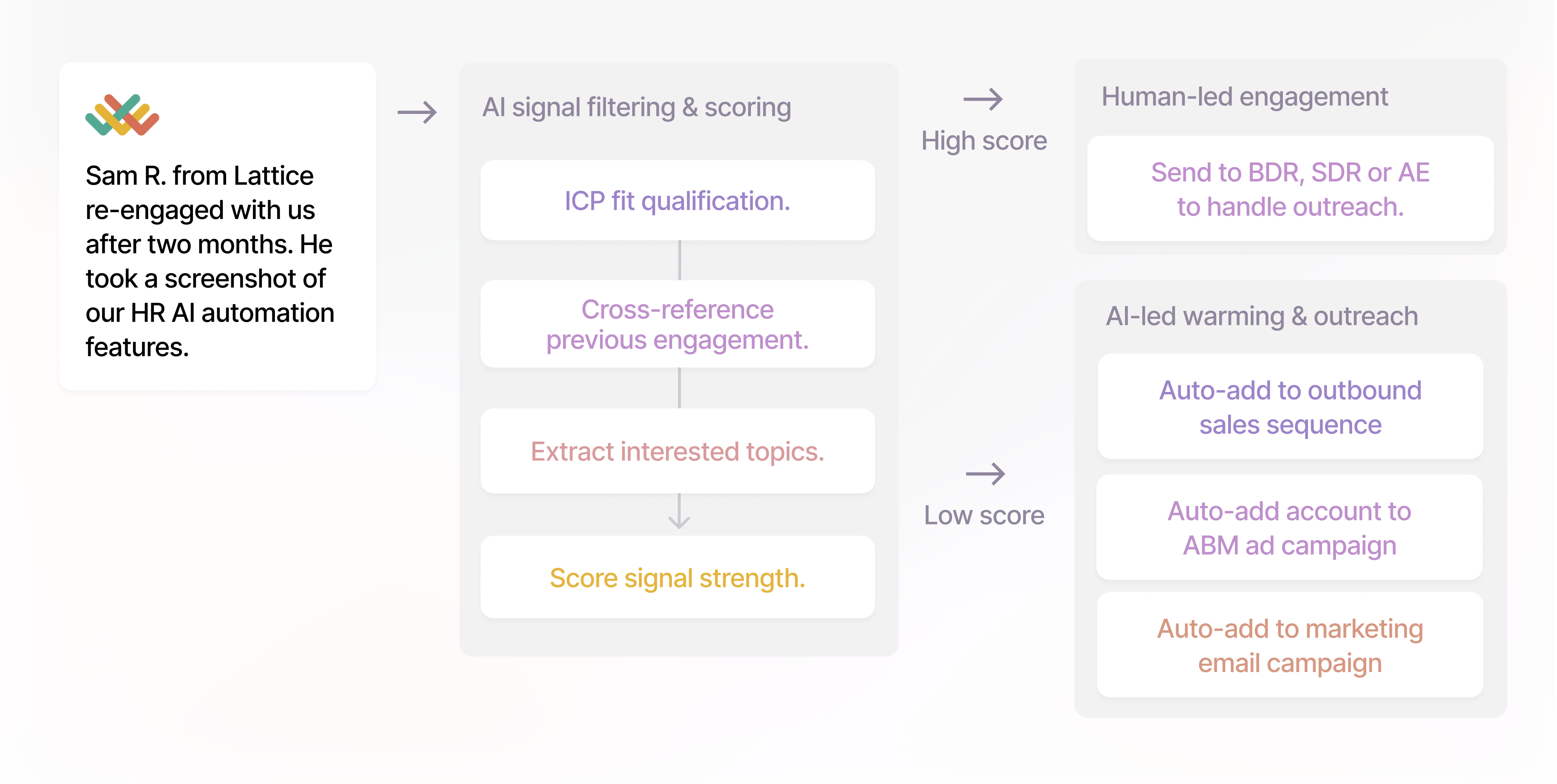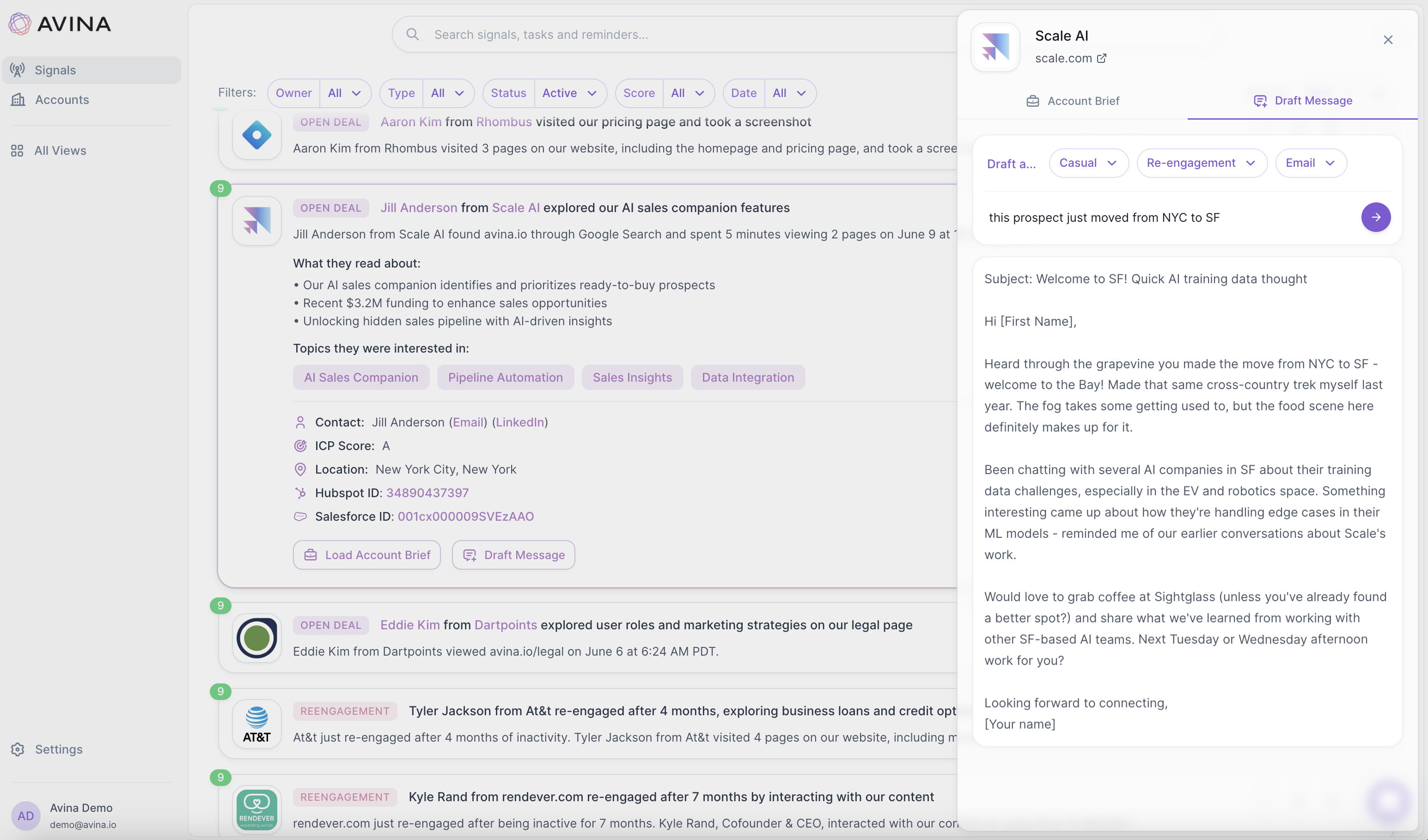For a refresher on the different types of buying signals and why they matter, check out Part 1 of this guide.
Spotting intent data is only half the battle; the real difference-maker is what you do with it.
When a meaningful signal occurs, you should be ready to quickly follow up with a relevant, personalized message or a phone call. Yes, picking up the phone right away can be extremely effective!
But what makes a signal meaningful? And how can you craft your messaging with the right value proposition and tone?
Today, we’ll discuss how to act on buying signals in real-time, allowing you to turn raw intent into booked meetings and ensuring you never miss a high-intent prospect again.
With so many different types of potential signals, it’s critical to create a strategy for what to do with each one depending on the signal itself, the fit of the target account, and any prior context.
First, set up a scoring system for what constitutes a strong signal versus a mild one and determine actions accordingly. For each signal, you should define why it matters based on your company’s market, constraints, and needs.
Ideally, you’ll want to create an account score that includes the signal strength, prior signals and engagement, and how closely the account matches your target ideal customer profile (ICP). That way your sales reps can simply sort on that score to find the best leads across the entire market.
Depending on the complexity of your target market and sales organization, creating accurate and useful account scores can be a challenge. Traditional scores are points-based - meaning that an email click might be worth 5 points, and a pricing page visit worth 20 points. The downsides of this method are that point values tend to be arbitrary and it can’t take into account unstructured inputs like call transcripts. Even machine learning-based scores are tough to get right because models need a lot of well-structured data to create accurate results.
Modern sales tools like Avina offer LLM-based scoring that automatically takes into account all of the factors mentioned above paired with the latest reasoning models, resulting in scores that stand up to common sense. That way, when your reps open their dashboard in the morning, they see a feed of top potential opportunities that they can trust.
Speed is crucial. Prompt outreach can be the difference between booking a meeting and being ignored. The key is to eliminate lag time between signal and follow-up.
Aim to have real-time alerts for the highest priority signals. These could be automated Slack messages, email notifications, or tasks created in your CRM.
For even better capture, set up workflow automations that immediately trigger drip sequences, ad retargeting, or nurture campaigns.
Depending on how your signal data provider works, you may need to do contact enrichment so your team can immediately reach the most relevant person. Tools like Clay can be included in your signals pipeline to retrieve contact information, or tools like Avina will automatically find your target persona for every signal.

Once you’ve determined it’s the right time to reach out, you’ll want to leverage the intel you from the signal to send a message that will resonate.
Rather than referencing the buying signal directly (e.g., “I saw you looked at our case study on X”), which may sound a bit creepy, use what the signal tells you about their pain point to tailor your message in a natural, helpful way. For example, if a prospect showed interest in a specific case study, you might email them offering another resource related to that topic.
Here’s a common framework for personalized outreach:
By aligning your message to what the buyer is thinking about, you transform outreach from a cold call into a warm, consultative touch.
Capturing and acting on all these buying signals can seem overwhelming. But it doesn’t have to be. AI-based tools can simplify this process by consolidating diverse signals into a single platform, providing your revenue team with actionable insights and AI-assisted actions.
In the past, reps had to manually scan CRM data, and marketing activity timelines, and news, piecing together information in dozens of Chrome tabs. Kudos to the sales teams that developed strict training and discipline to consistently perform, but it’s hard to imagine even the best sales teams were not missing golden opportunities.
Imagine your sales reps starting every day with a fresh list of the strongest opportunities based on signals and fit. When a new buying signal comes through, they get a real-time notification and along with it, a phone number and pre-written message that incorporates relevant talking points about that signal.
When they need to qualify the account further, they have AI agents to do account research for them. With this information at hand, you can easily tweak, approve, and send, speeding up response time while keeping message quality high - all the time.

Even better, as you see which signals and outbound converts, you can refine your strategy over time.
Using AI to unify all signals, prioritize, and push actions into the CRM is faster, more reliable, and easy to scale. This frees up reps to do what they do best: building personal relationships and matching pain points with potential solutions.
We wrote a series on the Future of Revenue that dives into how modern AI sales tools are changing the game - check it out!
* * *
Avina is a signals-based GTM automation platform for B2B teams that uses cutting-edge artificial intelligence to convert data into revenue.
Ready to move from chaos to clarity? Book a demo with us here.
Have questions, feedback, or ideas? Reach out to hello@avina.io - we would love to hear from you!
Here’s what our customers are saying:
“Avina has completely changed the way I work. Before, I felt like I was shooting in the dark to get responses, but now I have the highest propensity buyers being delivered to my doorstep, and I can focus on closing those deals.”
- James, Director of Strategic Partnerships, Ingenious (Case study)
“In sales, it’s all about getting more quality at-bats. Products that help do better cold outbound are faster horses - Avina’s warm inbound alerts is a car.”
- Ethan Pope, VP Revenue Operations, Nitrogen Wealth